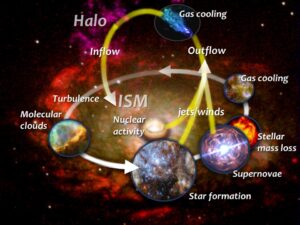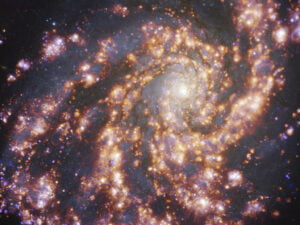Nearby galaxies like the Southern Pinwheel Galaxy, M83, are well-studied neighbours to our Milky Way. Being external galaxies, we get an outsiders view of the galaxies in the local Universe, allowing us to see these galaxies as a whole. This means we can measure their global properties to link to large galaxy surveys, determine their group environment and even observe their large-scale gas-cycle – the balance between gas replenishment (via inflows from the intergalactic medium) and consumption (via star formation) or ejection (outflows), a key driver of galaxy evolution.
Our knowledge of the external and internal gas cycle and its connection to galaxy properties and their environments is still somewhat limited, due to lack of large, multi-wavelength data sets with high resolution observations. Only now thanks to extragalactic surveys with the leading and next-generation telescopes such as the Hubble & James Webb Space Telescopes, the European Southern Observatories VLT, the Square Kilometre Array (SKA) and its pathfinders are we linking star formation and the gas-cycle from the smallest to galactic scales.
With such detailed data we are able to break apart and understand galaxy formation in ways not possible before and seek answers to big questions such as: what is the relation between gas content and galaxy structure? Why star-forming systems such as our own Milky Way have not run out of fuel a long time ago? How did they get their gas? What are the most important processes regulating gas accretion and gas loss in the local Universe, and how do they depend on both the local and extragalactic environment & properties of galaxies?, and how does this drive the distribution of stars and their mass function in galaxies?.
Here at ICRAR, we have access to exquisite multi-wavelength data on nearby galaxies, and are leading some of these surveys, such as WALLABY (which is performing the largest ever survey of atomic hydrogen content of galaxies in the local Universe), MAUVE (a brand-new large program with the VLT/MUSE instrument to study how star formation and interstellar medium of galaxies are affected by the cluster environment), and PHANGS (which aims to understand the interplay of the small-scale physics of gas and star formation with galactic structure). Based on these data we offer multiple projects both observational and theory:
- The gas cycle as a function of environment (Barbara Catinella)
- 3D modelling of galaxies (Brent Groves)
- Quantifying the energetic feedback from massive stars (Brent Groves)
- Understanding the distribution of metals and dust in galaxies over cosmic time (Brent Groves)
- An in-depth look at galaxy evolution in large clusters with MAUVE (Barbara Catinella)
For more details of these projects or related ones, please contact the primary supervisor. Students accepting these projects will acquire skills in processing and analysis of multi-wavelength data sets, querying and managing large data sets, statistical analysis, and comparison with theory.


This image, taken with the Multi-Unit Spectroscopic Explorer (MUSE) on ESO’s Very Large Telescope (VLT), shows the nearby galaxy NGC 4254.

